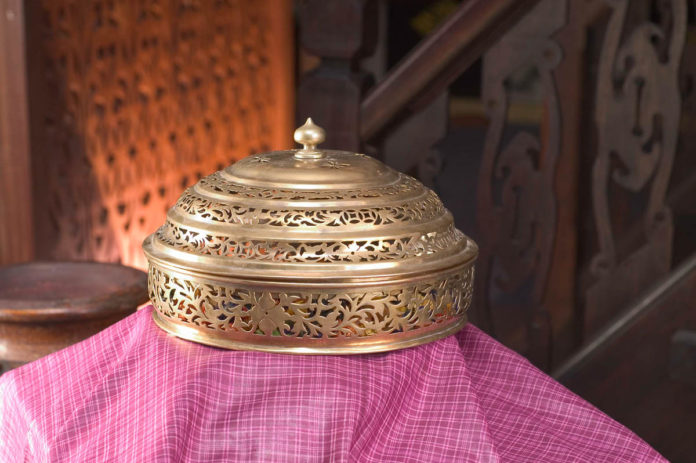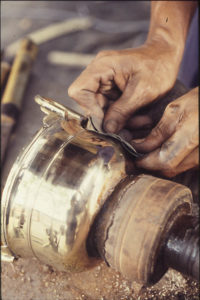
It is believed that the art of casting brass, an alloy of copper and zinc, was introduced from Thailand to Terengganu and Kelantan on the east coast of Peninsular Malaysia around 300 years ago. Brass offered a much cheaper alternative to Malay villagers than the silver or gold reserved for royalty and it became an important part of Malay domestic ware as well as for social occasions and religious ceremonies.
Malay brass comprises two types: yellow brass, composed of one part zinc to eight parts scrap brass, and white brass, which contains a higher proportion of zinc and is composed of about five parts brass to two parts nickel. Both types are cast in the “lost wax” method, in which moulded wax is replaced by molten metal in a series of laborious, age-old processes.

Yellow brass is commonly used for making functional objects, such as large serving trays, covered cooking pots and bowls with and without handles, kettles, spittoons (for betel chewers), incense burners, oil lamps and cake moulds. White brass, which has a mirrored finish, is mainly used for more decorative objects, such as betel (sirih) sets, tobacco boxes, rose water sprinklers and pedestal trays. Many brass items continue to be passed down as family heirlooms. Larger items made by Terengganu craftsmen include the caklempung, 6–8 brass gongs set in a row on a wooden stand, played as part of a gamelan ensemble.
Much of Malay brassware is plain, simple and unadorned, or limited to simple floral and vegetal motifs worked within geometric panels, scallops along lips and edges, and short excerpts from the Qur’an.
Despite its popularity in the past, the crafting of brass has declined in recent decades due to competition from imported iron, steel, aluminium and plastic items and cheaper brassware from India, Thailand and Burma, as well as the outmoded and time-consuming method of production. Thus, only a handful of brass craftsmen remain active in Malaysia, mostly in Terengganu, among them master craftsman Salleh bin Mohd.
Written in collaboration with Fiona Wong




